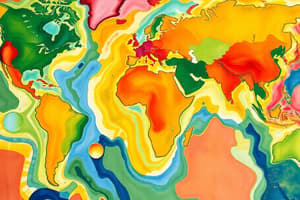Podcast
Questions and Answers
The branch of geography that studies the impact of human activities on the environment and the relationships between people and places is called ______ geography.
The branch of geography that studies the impact of human activities on the environment and the relationships between people and places is called ______ geography.
human
A place's position on the Earth's surface, described by latitude and longitude, is known as its ______.
A place's position on the Earth's surface, described by latitude and longitude, is known as its ______.
location
The ratio of map distance to actual distance is referred to as the ______ of a map.
The ratio of map distance to actual distance is referred to as the ______ of a map.
scale
Flashcards are hidden until you start studying
Study Notes
Branches of Geography
- Human Geography: Studies the impact of human activities on the environment and the relationships between people and places.
- Physical Geography: Examines the natural environment and the processes that shape it, including climate, landforms, and ecosystems.
Key Concepts
- Location: A place's position on the Earth's surface, described by latitude and longitude.
- Place: A specific location with its own unique characteristics, such as culture, economy, and environment.
- Region: A larger area defined by shared characteristics, such as climate, language, or politics.
- Scale: The level of detail or breadth of study, ranging from local to global.
Map Skills
- Map Projections: Methods of representing the curved Earth on a flat surface, such as Mercator or Gall-Peter.
- Scale: The ratio of map distance to actual distance.
- Legend: The key to understanding symbols and colors used on a map.
- Latitude and Longitude: The grid system used to locate points on the Earth's surface.
Geographic Features
- Mountains: Elevated landforms formed by tectonic plate movement.
- Plateaus: Elevated areas of land formed by volcanic activity or erosion.
- Valleys: Low areas of land between hills or mountains.
- Islands: Landforms surrounded by water.
- Deserts: Regions with low rainfall and limited vegetation.
- Oceans: Large bodies of saltwater that cover over 70% of the Earth's surface.
Human-Environment Interactions
- Environmental Impact: The effects of human activities on the natural environment.
- Sustainability: The ability of a system to maintain itself over time without depleting natural resources.
- Conservation: The preservation and protection of natural resources.
- Resource Management: The responsible use and allocation of natural resources.
Geographic Tools and Techniques
- GIS (Geographic Information System): A computer-based system for analyzing and displaying geographic data.
- Remote Sensing: The use of aerial or satellite imagery to gather data about the Earth's surface.
- Fieldwork: Direct observation and data collection in the field.
- Spatial Analysis: The study of the relationships between geographic phenomena.
Studying That Suits You
Use AI to generate personalized quizzes and flashcards to suit your learning preferences.




